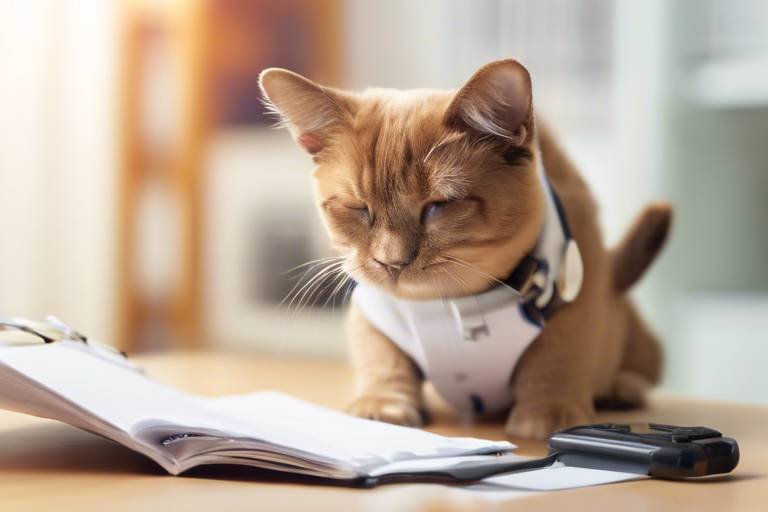The Importance of Pet Microchipping for Safety
In a world where pets are often considered part of the family, their safety is paramount. One of the most effective ways to ensure that your furry friend can always find their way back home is through microchipping. This little chip, no bigger than a grain of rice, holds the key to reuniting lost pets with their owners. Imagine the heartache of losing your beloved companion, only to realize that a simple procedure could have made all the difference. Microchipping not only offers peace of mind but also serves as a reliable form of identification that stands the test of time. So, let’s dive deeper into the critical role of pet microchipping and why it should be a top priority for every pet owner.
Microchipping is a straightforward and safe procedure that involves implanting a tiny chip under your pet's skin, usually between the shoulder blades. This chip contains a unique identification number linked to a database that holds your contact information. Think of it as a permanent ID card for your pet, one that can’t be lost or removed like a collar or tag. When a lost pet is found, a quick scan with a microchip reader reveals their ID number, allowing shelters and veterinarians to contact you quickly. This simple yet effective process is a game-changer in the quest for pet safety.
The benefits of microchipping your pet extend far beyond just having a unique ID. Let’s explore some of the key advantages:
- Permanent Identification: Unlike collars or tags that can be lost or taken off, microchips provide a permanent form of identification.
- Increased Recovery Rates: Studies show that microchipped pets are much more likely to be returned to their owners.
- Peace of Mind: Knowing your pet can be easily identified gives you a sense of security.
When it comes to identifying your pet, microchips are the gold standard. While collars and tags can fall off or get lost, a microchip remains securely in place under your pet's skin. This means that even if your pet manages to slip out of their collar during an adventure, they can still be identified and returned home. This permanent identification is crucial, especially in situations where pets may be lost for an extended period.
Microchips are designed to last a lifetime. They are made from biocompatible materials, ensuring they won’t degrade or wear out over time. Unlike collars that may fray or tags that may rust, microchips remain intact, providing a reliable option for pet identification. This durability means that once your pet is microchipped, you can rest easy knowing that their identification will be effective for years to come.
Most animal shelters and veterinary clinics are equipped with scanners that can read microchips. This compatibility is vital in facilitating the quick identification of lost pets and their owners. When a lost pet is brought to a shelter, the staff can scan for a microchip, which immediately provides them with the owner's contact information. This swift process can be the difference between a long wait for a reunion and a quick return home.
Research has shown that microchipped pets have a significantly higher chance of being returned to their owners compared to those without chips. In fact, studies indicate that microchipped dogs are over twice as likely to be returned than non-microchipped dogs. This statistic highlights the effectiveness of microchipping as a reliable identification method, proving that investing in this procedure is a wise choice for any pet owner.
The microchipping process is quick and straightforward, typically performed by a veterinarian. Understanding the steps involved can help alleviate any concerns pet owners may have. The procedure itself takes only a few minutes and involves inserting the microchip with a needle, much like a routine vaccination. It’s virtually painless and can be done during a regular vet visit.
Before proceeding with microchipping, it’s essential to consult with a veterinarian. They can provide valuable information about the procedure, its benefits, and any potential risks involved. This consultation is an excellent opportunity to ask questions and ensure that you are comfortable with the process. Remember, knowledge is power, and understanding what to expect can make the experience much smoother.
Once your pet is microchipped, the next crucial step is to register their microchip information with the relevant database. This registration ensures that your contact details are linked to the microchip, allowing for accurate identification and recovery if your pet goes missing. Make sure to keep your information up to date, especially if you move or change your phone number. This step is vital for ensuring that your pet can be returned to you without any hitches.
1. Is microchipping safe for my pet?
Yes, microchipping is a safe and minimally invasive procedure that has been used for many years. The chip is made from biocompatible materials and is designed to last a lifetime.
2. How much does microchipping cost?
The cost of microchipping can vary, but it typically ranges from $25 to $50, including registration in a database.
3. Will my pet feel pain during the procedure?
Most pets experience only a brief pinch, similar to a vaccination, and the discomfort is minimal.
4. How do I update my pet's microchip information?
You can update your pet's information by contacting the microchip registry where your pet is registered. Make sure to keep your contact details current.

Understanding Microchipping
Microchipping is a simple, safe procedure that involves implanting a tiny chip under a pet's skin. This chip, about the size of a grain of rice, contains a unique identification number linked to a database with the owner's contact information. Imagine having a permanent ID card for your furry friend that they can never lose! This innovative technology plays a crucial role in reuniting lost pets with their owners, acting like a beacon of hope in a world where pets can easily wander off and get lost.
But how does this tiny chip work? When a lost pet is found, animal shelters and veterinary clinics can scan the microchip using a handheld scanner. The scanner reads the chip's unique number, which can then be cross-referenced in a database to find the owner's details. It’s like having a GPS tracker for your pet, but without the need for batteries or charging! This process is quick and efficient, ensuring that pets can be identified and returned to their loving homes in no time.
One of the greatest advantages of microchipping is that it's a one-time procedure. Unlike collars or tags that can be lost, removed, or damaged, microchips provide a permanent form of identification. This means that even if your pet manages to slip out of their collar during a playful romp in the park, their microchip will remain intact and functional. In fact, the durability and longevity of microchips are remarkable; they are designed to last a lifetime, providing peace of mind for pet owners.
Furthermore, most animal shelters and veterinary clinics are equipped with scanners that can read microchips. This compatibility means that if your pet ever goes missing, the chances of them being identified and returned to you are significantly increased. Studies have shown that microchipped pets are far more likely to be reunited with their families than those without chips. In essence, microchipping is not just a safety measure; it’s a lifeline for pets and their owners.
In conclusion, understanding microchipping is essential for every pet owner. By opting for this simple and effective identification method, you are ensuring that your beloved pet has a safety net in place. Just like a life jacket for a swimmer, microchipping provides an extra layer of security, allowing you to enjoy your time with your furry friend without the constant worry of what might happen if they get lost.

Benefits of Microchipping
Microchipping your pet is not just a trend; it's a lifesaving decision that offers a myriad of benefits. Imagine this: your beloved furry friend wanders off, and the panic sets in. You search high and low, calling their name, but they’re nowhere to be found. This is where microchipping becomes a game-changer. It provides a permanent solution that collars and tags simply can't match. In fact, microchips are like little insurance policies for your pets, ensuring that if they ever get lost, they have a reliable way to be identified and returned home.
One of the primary advantages of microchipping is the permanent identification it provides. Unlike collars that can slip off or tags that can wear out, microchips are embedded under your pet's skin and remain there for life. This means that no matter how far they roam or how long they’re missing, their identity is securely stored and easily accessible. Most shelters and veterinary clinics are equipped with scanners that can read these microchips, making it a breeze to reunite lost pets with their worried owners.
Furthermore, the durability and longevity of microchips add another layer of security. These tiny devices are designed to withstand the test of time. They don't degrade or wear out, which means your pet's microchip will function perfectly for their entire life. Think of it as a tiny, unbreakable bond between you and your pet, ensuring that they can always find their way back to you, no matter the circumstances.
Another crucial benefit is the increased chances of recovery for lost pets. According to studies, microchipped pets are significantly more likely to be returned to their owners compared to those without chips. In fact, the recovery rate for microchipped pets can be as high as 52%, while non-microchipped pets have a recovery rate of only about 22%. This stark difference highlights just how effective microchipping is as a method of identification.
To illustrate the impact of microchipping, consider the following table that compares recovery rates between microchipped and non-microchipped pets:
| Type of Pet | Recovery Rate |
|---|---|
| Microchipped Pets | 52% |
| Non-Microchipped Pets | 22% |
Finally, microchipping provides peace of mind for pet owners. Knowing that your pet has a permanent form of identification can alleviate the anxiety that comes with the thought of them getting lost. It’s like having a safety net in place; you can enjoy your time with your pet without constantly worrying about what might happen if they stray too far. This peace of mind is invaluable, allowing you to focus on the joy they bring into your life.
In conclusion, the benefits of microchipping are undeniable. From providing permanent identification and increasing recovery rates to offering peace of mind, microchipping is a simple yet effective way to ensure your pet's safety. So, if you haven’t already, consider microchipping your furry companion today. It’s a small step that can make a gigantic difference!
Permanent Identification
When it comes to keeping our beloved pets safe, is crucial. Unlike collars or tags that can easily be lost or removed, microchips offer a reliable and tamper-proof solution. Imagine a world where your pet could always find their way back home, no matter what happens. That's the power of microchipping! This small device, about the size of a grain of rice, is implanted just beneath your pet's skin and contains a unique identification number linked to your contact information in a secure database.
One of the most significant advantages of microchips is their durability. These chips are designed to last a lifetime, meaning they won't wear out or degrade over time like collars can. Think of it as a permanent safety net for your furry friend. Whether your pet gets lost during a walk in the park or runs away during a thunderstorm, their microchip will be there, silently waiting to help reunite you.
Furthermore, microchips are compatible with most animal shelters and veterinary clinics, which are equipped with scanners that can read these chips. This compatibility is vital because it facilitates the quick identification of lost pets and their owners. In a stressful situation, like searching for a lost pet, having a microchip can make all the difference. It’s like having a secret key that opens the door to your pet's safe return.
In addition to being an effective form of identification, microchips also provide peace of mind for pet owners. Knowing that your pet can be identified at any moment allows you to relax and enjoy life with them. After all, pets are family, and just like you would want to ensure your family members have a way home, the same should apply to your pets.
To summarize the key points about permanent identification through microchipping, let's take a look at this table:
| Feature | Microchips | Collars/Tags |
|---|---|---|
| Durability | Lifetime | Wear out over time |
| Risk of Loss | None | Can be lost or removed |
| Compatibility with Shelters | High | Variable |
In conclusion, microchips represent a permanent and effective means of identifying pets, ensuring that they can always find their way back home. With microchipping, you can rest easy knowing that your furry family member is just a scan away from being reunited with you!
- What is a microchip? A microchip is a tiny electronic device implanted under your pet's skin that contains a unique identification number.
- Is the microchipping procedure painful for my pet? The procedure is quick and generally causes minimal discomfort, similar to a vaccination.
- How do I ensure my pet's microchip information is updated? Always register your pet's microchip with your contact details and update the information if you move or change phone numbers.
- What should I do if my pet gets lost? Immediately contact local shelters and veterinary clinics, and provide them with your pet’s microchip number for quick identification.
Durability and Longevity
When it comes to ensuring the safety of our beloved pets, one of the most critical aspects to consider is the durability and longevity of microchips. Unlike collars or tags that can easily be lost, damaged, or removed, microchips are designed to be a permanent solution for pet identification. The microchip itself is encased in a biocompatible glass tube, which protects it from the elements and ensures that it remains functional for the lifetime of your pet.
Imagine a tiny, unassuming chip that can make a world of difference in keeping your furry friend safe and sound. Once implanted under the skin, usually between the shoulder blades, this chip is virtually indestructible. It doesn’t degrade over time, meaning that even after years of frolicking in the park or playing rough at home, the microchip remains intact and ready to help reunite you with your pet if they ever go missing.
Moreover, the technology behind microchips has advanced significantly over the years. Here are some key points that highlight their durability and longevity:
- Waterproof and Shockproof: Microchips are designed to withstand various environmental factors, including water exposure and physical impacts, ensuring they remain functional regardless of your pet’s adventures.
- Lifetime Guarantee: Most manufacturers offer a lifetime guarantee for their microchips, which means that as long as your pet is alive, the chip will work effectively without needing replacement.
- Compatibility: Microchips are standardized across many veterinary clinics and shelters, making it easy for them to scan and retrieve your pet’s information, regardless of where they are found.
In conclusion, the durability and longevity of microchips make them an invaluable tool for pet identification. They provide pet owners with the confidence that their pets can be easily identified and returned home safely, no matter how far they wander. With a microchip, you’re not just investing in a piece of technology; you’re investing in peace of mind for both you and your furry companion.
Q: How long does the microchipping procedure take?
A: The microchipping procedure is quick and typically takes just a few minutes at your veterinarian's office.
Q: Is the microchip painful for my pet?
A: Most pets experience only minimal discomfort, similar to getting a vaccination. The benefits far outweigh any temporary discomfort.
Q: Can microchips be removed?
A: While technically possible, removing a microchip is not recommended and can be invasive. It’s best to leave it in place for your pet’s safety.
Q: What should I do if my contact information changes?
A: It's crucial to update your contact information in the microchip registry to ensure you can be reached if your pet is found.
Compatibility with Shelters
When it comes to the safety of our beloved pets, one of the most reassuring aspects of microchipping is its compatibility with shelters and veterinary clinics. Imagine this: your furry friend goes missing, and the heartache is palpable. However, if your pet is microchipped, the chances of a happy reunion are significantly enhanced. Most animal shelters and veterinary practices are equipped with specialized scanners that can read microchips quickly and efficiently. This means that, should your pet end up in a shelter, they can be scanned almost immediately, allowing staff to access your pet's identification information within seconds.
Moreover, the process is incredibly seamless. Shelters often have protocols in place that prioritize checking for microchips as soon as a lost animal arrives. This not only expedites the identification process but also minimizes the stress for both the pet and the owner. In fact, studies have shown that microchipped pets are up to twenty times more likely to be reunited with their families than those without microchips. This statistic alone underscores the importance of microchipping as a fundamental safety measure for pet owners.
To illustrate the point further, consider the following table that showcases the recovery rates of microchipped pets compared to those without:
| Identification Method | Recovery Rate |
|---|---|
| Microchipped Pets | 74% |
| Non-Microchipped Pets | 15% |
As you can see, the difference is staggering. The presence of a microchip not only provides a permanent form of identification but also integrates seamlessly into the systems used by shelters. It's a win-win situation! Not only does it help in reuniting pets with their families, but it also allows shelters to manage their resources more effectively, ultimately leading to better care for all animals in their facilities.
In conclusion, the compatibility of microchips with shelters is a crucial factor that enhances the safety and well-being of pets. It acts as a bridge between lost pets and their worried owners, ensuring that every effort is made to bring them back home. So, if you haven't yet microchipped your pet, now is the time to consider this simple yet effective solution for their safety.
- How long does the microchipping process take? The actual implantation of the microchip takes only a few minutes, similar to a routine vaccination.
- Is microchipping safe for my pet? Yes, microchipping is a safe and well-established procedure. The chip is biocompatible and does not cause harm to your pet.
- What should I do if my pet gets lost? If your pet goes missing, immediately contact local shelters and veterinary clinics to report your pet and provide them with your microchip information.
Recovery Rates
When it comes to the heart-wrenching experience of losing a pet, the statistics surrounding recovery rates can be a beacon of hope for pet owners. Studies have shown that microchipped pets are significantly more likely to be returned to their families than those without this crucial form of identification. In fact, according to recent research, the recovery rate for microchipped dogs is around 52% to 74%, while for cats, it can be as high as 38% to 71%. These numbers tell a compelling story about the effectiveness of microchipping as a safety measure.
Imagine the relief of knowing that if your furry friend wanders off, there's a much higher chance they will find their way back home. This is particularly important considering that pets can easily slip out of collars or tags, especially in stressful situations. Microchips, on the other hand, are embedded under the skin and remain with the pet for life. This permanence is what sets microchipping apart from traditional identification methods.
Additionally, it's worth noting that many shelters and veterinary clinics are equipped with microchip scanners, making it easier to identify lost pets. Once a microchip is scanned, the unique identification number is linked to the owner's contact information in a database, allowing for a swift reunion. This technology is a game-changer in the world of pet recovery.
To illustrate the impact of microchipping, consider the following table that summarizes recovery rates based on various studies:
| Type of Pet | Recovery Rate with Microchip | Recovery Rate without Microchip |
|---|---|---|
| Dogs | 52% to 74% | 15% to 20% |
| Cats | 38% to 71% | 2% to 5% |
These statistics highlight the stark contrast between microchipped and non-microchipped pets when it comes to recovery rates. The peace of mind that comes with knowing your pet has a greater chance of returning home is invaluable. So, if you're still on the fence about microchipping, consider this: it’s not just about identification; it’s about ensuring that your beloved pet has the best possible chance of coming back to you, no matter the circumstances.
- What is a microchip? A microchip is a small electronic chip that is implanted under your pet's skin, containing a unique identification number linked to your contact information.
- Is the microchipping process painful for pets? The procedure is quick and similar to getting a vaccination, with minimal discomfort for your pet.
- How often should I update my microchip information? You should update your information whenever you change your address, phone number, or ownership of the pet.
- Can microchips be tracked like GPS? No, microchips do not have GPS capabilities; they simply provide a unique ID that can be scanned by shelters and vets.
- Are there any risks associated with microchipping? Microchipping is generally safe, but as with any medical procedure, there can be rare complications. Always consult your vet if you have concerns.

The Microchipping Process
Microchipping your pet is a straightforward and stress-free procedure that can be completed in just a few minutes. It’s essential to understand the steps involved to ensure a smooth experience for both you and your furry friend. The first step in the microchipping journey is a consultation with a veterinarian. During this meeting, the vet will explain the entire process, discuss the benefits, and address any concerns you might have. It’s a great opportunity to ask questions and gain peace of mind. After all, your pet's safety is paramount!
Once you’ve decided to go ahead with microchipping, the actual procedure is quite simple. The veterinarian will use a special syringe to implant a tiny chip, roughly the size of a grain of rice, under your pet's skin, usually between the shoulder blades. This chip is a passive device, which means it doesn’t have a battery and is only activated when a scanner is passed over it. The procedure is relatively painless, similar to getting a routine vaccination, and most pets recover immediately, returning to their playful selves in no time.
After the microchip is implanted, it’s crucial to register your pet’s information in a microchip database. This step is often overlooked but is vital for ensuring that your pet can be identified and returned to you if they ever go missing. You’ll need to provide details such as your contact information and your pet’s medical history. It’s a good idea to keep this information updated, especially if you move or change phone numbers. Remember, a microchip is only as effective as the information linked to it!
To give you a clearer picture of the entire microchipping process, here’s a quick overview:
| Step | Description |
|---|---|
| 1. Consultation | Discuss the procedure with a veterinarian and address any concerns. |
| 2. Implantation | A tiny chip is injected under the skin using a syringe. |
| 3. Registration | Register your pet’s microchip information in a database. |
| 4. Update Information | Keep your contact details current to ensure effective identification. |
In conclusion, the microchipping process is not only quick and easy but also a vital step in ensuring your pet's safety. By taking this simple action, you’re significantly increasing the chances of being reunited with your beloved companion should they ever go missing. So, why wait? Schedule that appointment today and give yourself the peace of mind that comes with knowing your pet can always find their way back home!
Here are some common questions pet owners often have about microchipping:
- Is microchipping painful for my pet? - Most pets experience minimal discomfort, similar to a vaccination.
- How long does the chip last? - Microchips are designed to last a lifetime and do not require any maintenance.
- What happens if my pet gets lost? - If your pet is found, shelters and vets can scan the chip and access your contact information for a quick reunion.
- Can I track my pet's location with a microchip? - No, microchips do not provide real-time GPS tracking; they only store identification information.
Consultation with a Veterinarian
Before diving into the world of microchipping, it's crucial to have a . This step is often overlooked, but it plays a vital role in ensuring both you and your pet are fully informed about the procedure. During this consultation, your vet will explain the microchipping process in detail, addressing any questions or concerns you might have. Think of it as a friendly chat where you can gather all the necessary information to make an informed decision.
One of the key aspects discussed will be the benefits of microchipping. Your veterinarian will highlight how microchips serve as a permanent form of identification, unlike collars that can easily be lost or removed. They might even share heartwarming stories of pets that were successfully reunited with their owners thanks to microchips, making the idea of microchipping feel more tangible and important. Furthermore, your vet will also cover potential risks, which are minimal but worth discussing. Understanding these factors can help alleviate any worries you might have, ensuring a smoother experience for both you and your furry friend.
During the consultation, it’s also a great opportunity to ask about the different types of microchips available. While most microchips function similarly, there are variations in terms of frequency and compatibility with scanners. Your veterinarian can guide you on the best choice for your pet, ensuring that the microchip you select is compatible with local shelters and veterinary clinics. This compatibility is crucial because it directly impacts the chances of a successful reunion if your pet ever goes missing.
After discussing the technicalities, your vet will likely advise you on the best timing for the procedure. Microchipping can be done during a routine vet visit, but it’s also common to have it done during spaying or neutering. This way, your pet experiences only one visit to the vet instead of multiple. Additionally, your veterinarian will emphasize the importance of registering your pet’s microchip information with the appropriate database, as this is a critical step for ensuring that your pet can be identified and returned to you if lost.
In summary, the consultation with a veterinarian is not just a formality; it's a crucial step in the microchipping journey. It equips you with the knowledge you need and helps you feel more confident about the decision. Remember, your vet is there to support you and your pet, so don’t hesitate to ask questions or express any concerns you may have. After all, this is about ensuring the safety and well-being of your beloved companion!
- How long does the microchipping process take?
Microchipping is a quick procedure, typically taking only a few minutes. - Is microchipping painful for my pet?
The process involves a simple injection, similar to a vaccination, and most pets experience minimal discomfort. - What should I do if my pet goes missing?
Immediately contact local shelters and veterinary clinics, and ensure your pet’s microchip information is up to date. - Can I track my pet with a microchip?
No, microchips do not have GPS capabilities; they only store identification information that can be read by scanners.
Aftercare and Registration
Once your beloved pet has undergone the microchipping procedure, it’s crucial to focus on two key aspects: aftercare and registration. The aftercare process is relatively simple, but it plays an important role in ensuring your pet’s well-being. After the microchip is implanted, the veterinarian will typically advise you to keep an eye on the injection site for any signs of swelling, redness, or discomfort. This is a common practice with any vaccination or implant procedure. If you notice anything unusual, don't hesitate to contact your vet for advice. Remember, your furry friend deserves the best care!
Now, let’s talk about registration, which is arguably the most vital step following microchipping. While the microchip itself is a powerful tool for identification, it’s the information linked to that chip that truly makes it effective. Most microchips come with a unique identification number that is registered in a database. This database holds your contact information, ensuring that if your pet is found, the person who discovers them can easily reach out to you.
To register your pet’s microchip, follow these simple steps:
- Visit the Microchip Company’s Website: Each microchip company has its own registration process, so make sure to go to the correct website.
- Provide Required Information: Fill out the necessary fields, which typically include your pet's microchip number, your contact information, and any other relevant details.
- Keep Your Information Updated: If you move or change your phone number, make sure to update your details in the microchip database. This is crucial for ensuring a swift reunion with your pet.
In addition to these steps, it’s a good idea to keep a record of your pet’s microchip information in a safe place at home. This can include the microchip number, the name of the company that issued the chip, and the contact details for the database. Having this information handy can save precious time if your pet ever goes missing.
Lastly, always encourage friends and family to check for microchips if they ever find a lost pet. Awareness is key! By spreading the word about microchipping and its benefits, we can create a community that looks out for our furry companions. Remember, the more people who know about microchipping, the higher the chances of lost pets being reunited with their families. It’s a small step that can make a world of difference.
Here are some common questions pet owners often have regarding microchipping:
| Question | Answer |
|---|---|
| Is microchipping painful for my pet? | No, the procedure is similar to a vaccination and is generally quick with minimal discomfort. |
| How much does microchipping cost? | Costs vary by location and clinic, but it typically ranges from $25 to $75, including registration. |
| Can I microchip my pet at home? | It’s highly recommended to have a veterinarian perform the procedure to ensure it’s done safely and correctly. |
| What if my pet loses weight or gains weight? | The microchip remains effective regardless of your pet’s weight changes; it’s designed to function properly throughout their life. |
Frequently Asked Questions
- What is pet microchipping?
Pet microchipping is a simple and safe procedure where a tiny chip is implanted under your pet's skin. This chip contains a unique identification number that links your pet to your contact information, making it easier to reunite with them if they get lost.
- How does microchipping work?
Once your pet is microchipped, the chip can be scanned by a veterinarian or animal shelter. The scanner reads the chip's unique ID number, which is then used to access your contact information in a secure database, allowing for a quick reunion.
- Is the microchipping process painful for my pet?
The microchipping process is similar to getting a vaccination. It involves a quick injection, and while your pet may feel a brief pinch, it is generally well-tolerated and causes minimal discomfort.
- How long does microchipping last?
Microchips are designed to last a lifetime. They are durable and do not degrade over time, ensuring that your pet's identification remains intact as long as they live.
- What should I do after my pet is microchipped?
After microchipping, it's crucial to register your pet's information with the microchip company. This ensures that your contact details are up-to-date, which is essential for recovering your pet if they go missing.
- Can any veterinarian microchip my pet?
Yes, most veterinarians are trained to microchip pets. It's always a good idea to consult with your vet to ensure they have the proper equipment and experience to perform the procedure safely.
- What if my pet loses their microchip?
Microchips are designed to stay in place for life, so they typically do not get lost. However, if you suspect that the microchip has migrated or is not functioning, you can have it checked by a veterinarian during a routine visit.
- Are there any risks associated with microchipping?
Microchipping is considered a safe procedure with very few risks. Some pets may experience minor swelling or irritation at the injection site, but serious complications are rare.
- How much does pet microchipping cost?
The cost of microchipping can vary depending on the veterinary clinic, but it typically ranges from $25 to $75. This is a small price to pay for the peace of mind that comes with knowing your pet can be identified and returned if lost.
- Can I microchip my pet at home?
No, microchipping should only be performed by a trained professional, such as a veterinarian. This ensures that the chip is implanted correctly and safely.



















